Feb 19, 2021
State of the Position: Questions remain for Blue Jays’ rotation
It’s staff ace Hyun-Jin Ryu and then everybody else, with almost zero certainty beyond the lefty, Scott Mitchell writes.
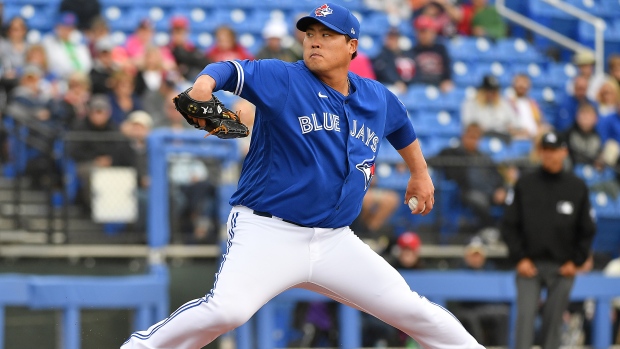
All in all, the Toronto Blue Jays’ front office still gets an A grade for its off-season work.
When you lure a dynamic franchise-altering player like George Springer, something many didn’t believe was possible at the outset, that’s enough right there.
Make an already-strong lineup even better? Check.
Fortify the bullpen with both depth and high-leverage options? Check.
Add impact to the rotation? Not so much.
With a budget to adhere to and a so-so market of starting pitching options available, the Jays decided re-signing lefty Robbie Ray in the early days of free agency for a single season at $8 million and trading for reclamation project Steven Matz was enough for now.
Jake Odorizzi, an arm the Jays have checked in on multiple times in the past, remains on the market, but he’d simply be another name to add to the mix, rather than any sort of solution.
For now, after finishing 17th in baseball last year with a 4.55 ERA from the rotation, manager Charlie Montoyo heads into 2021 with mostly the same options at his disposal.
As of today, it’s Hyun-Jin Ryu and then everybody else, with almost zero certainty beyond the soon-to-be 34-year-old lefty, who was mostly brilliant last summer in his first season of a four-year deal.
But even though the Jays will need to add another impact arm or two in order to fancy themselves any sort of real October threat, the trade deadline will present opportunities to do just that.
It’s the David Price blueprint from 2015, one that came oh-so close to getting the franchise back to the World Series.
To get to that point, the Jays simply have to piece things together creatively for the first couple months of a long season, and there are ways to do so if things break right.
Easier said than done, however.
Projected Starting Rotation
| Player | Situation | 2020 IP | ERA | FIP | fWAR |
|---|---|---|---|---|---|
| Hyun-Jin Ryu (L) | SP1 | 67.0 | 2.69 | 3.01 | 1.8 |
| Robbie Ray (L) | SP2 | 51.2 | 6.62 | 6.50 | -0.4 |
| To be determined | SPs 3-5 | - | - | - | - |
Competing for Jobs
| Player | Age | 2020 IP | ERA | FIP | fWAR |
|---|---|---|---|---|---|
| Nate Pearson (R) | 24 | 18.0 | 6.00 | 7.19 | -0.3 |
| Tanner Roark (R) | 34 | 47.2 | 6.80 | 6.86 | -0.6 |
| Steven Matz (L) | 29 | 30.2 | 9.68 | 7.76 | -0.6 |
| Ross Stripling (R) | 31 | 49.1 | 5.84 | 6.15 | -0.3 |
| Julian Merryweather (R) | 29 | 13.0 | 4.15 | 2.27 | 0.5 |
| Thomas Hatch (R) | 26 | 26.1 | 2.73 | 4.14 | 0.2 |
| Trent Thornton (R) | 27 | 5.2 | 11.12 | 2.66 | 0.2 |
| Anthony Kay (L) | 25 | 21.0 | 5.14 | 4.95 | -0.1 |
PROSPECTS ON THE 40-MAN
RHP Elvis Luciano
JOB BATTLES
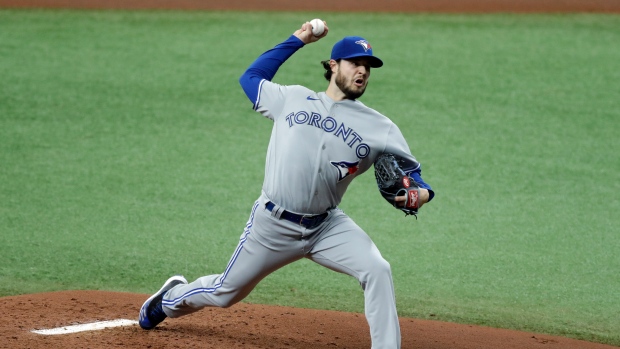
The rotation lined up above assumes a traditional five-man rotation that takes the ball every fifth day with the goal to go five, six or seven innings and then hand things over to an improved bullpen.
That’s not likely to happen.
Ryu will be that guy, and Ray will likely be given a chance to pitch deep into games, as well. From there, it gets murky.
In a perfect world, Matz and Roark would show they’re capable of doing the same, but the odd collection of one-or-two-times-through-the-order arms screams piggyback scenarios and a daily interrogation of Montoyo as to who is getting the ball in the first inning the following day.
It’s not exactly exciting and sexy for fans, but it has been proven to work in the regular season if you have a stockpile of quality arms that you can keep fresh and use in advantageous spots.
The stockpile is there, but the quality of those arms will be in question until they get into the regular season and prove they can get hitters out.
There’s also the extreme upside of a 6-foot-6 Florida kid named Nate Pearson, who you’ll read more about below, and Hatch, who's a quiet breakout candidate.
BIGGEST STRENGTH

Without Ryu last year, the Jays don’t even sniff the postseason.
He earned his (prorated) $20 million last year without a doubt, spinning a 2.69 ERA across 12 starts to finish third in American League Cy Young voting.
He may be the most important player on the roster and his health in 2021 is absolutely vital to the Blue Jays’ hopes.
BIGGEST WEAKNESS
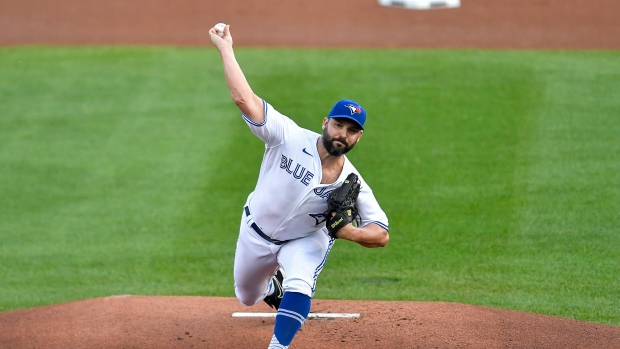
Not to get overly snarky here, but the answer to the question of biggest weakness after Ryu might be “everything else.”
For now.
Signed for two years and $24 million, Tanner Roark was a disaster in his first year as a Blue Jays, and it wasn’t totally unexpected.
Predictably, the big right-hander was pummelled by the home run ball, allowing 14 of them across 47.2 innings and finishing with a 6.80 ERA.
The Jays are hopeful that was a small sample size and think he’ll bounce back.
That might be tough in tiny TD Ballpark.
With the other options, there are either iffy track records of health (Julian Merryweather, Trent Thornton), or they’re simply unproven like Thomas Hatch, Anthony Kay and Pearson. In some cases, both.
If Ross Stripling can find his curveball and command, he could surprise, but both of those things went awry last year, and the Los Angeles Dodgers gave up.
HOW THINGS COULD GO WRONG
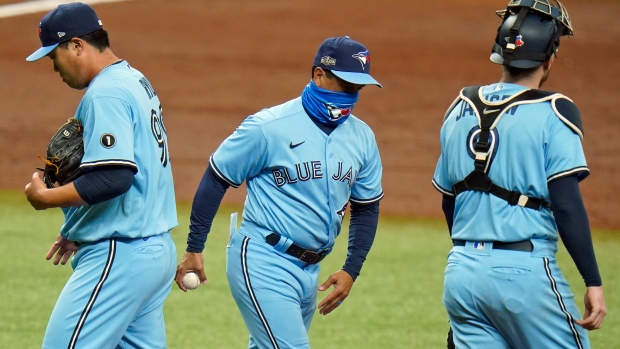
For starters, Ryu needs to take the ball at least 30 times and get results. Any sort of IL stint for their ace would be really bad.
They’re also counting on a breakout or two and a return to mid-rotation form from at least one of Ray, Roark or Stripling.
If they don’t get both of those, the pitching staff as a whole could be in trouble.
POTENTIAL BREAKOUT
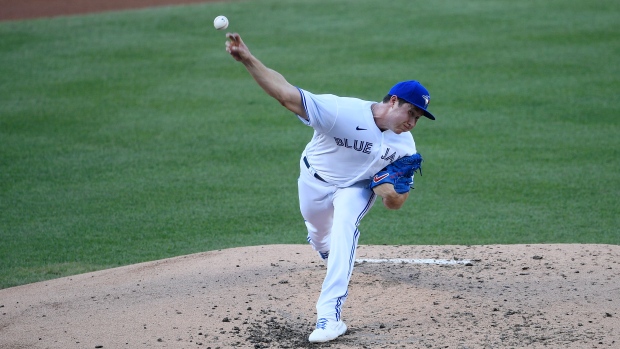
RHP Nate Pearson
Big Nate might be the biggest wildcard on the entire roster.
After debuting last summer in D.C. with major fanfare, Pearson’s stuff looked flat and the command was off in the starts that followed, and eventually we found out why when a flexor strain in his right elbow landed him on the injured list in mid-August.
It was a scary situation for a prospect so key to the Jays’ future rotation plans, but Pearson avoided anything major and returned late in the season, capping things off six high-octane outs — he struck out five with ridiculous stuff — on the postseason stage against the Tampa Bay Rays.
The first key here is obviously health, but after throwing just 20 total innings last year and having a career high of just 103.2 frames from 2019, there’s no way the Jays will push the 24-year-old much past the century mark.
All eyes will be on the affable Odessa, Fla., native this spring, but 2022 might be the year when the reins come off.
BOUNCEBACK CANDIDATE
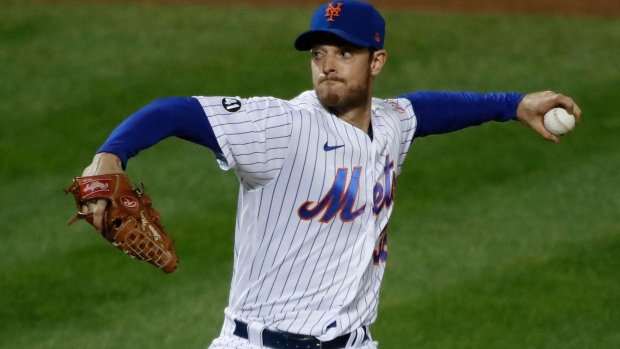
LHP Steven Matz
Acquired from the New York Mets for three prospects late last month, it’s easy to look at the 29-year-old lefty’s 9.68 ERA from last season and scoff.
Not to say it’s not scoff-worthy, but the underlying numbers have suggested Matz has some serious rotation upside, and he’s a lefty to boot.
The issue, however, is those underlying numbers have said that for some time now and Matz has just one useful season under his belt, and that came back in 2016 when he pitched to a 3.40 ERA across 22 starts.
It’s been up and down since.
When you look under the hood, Matz’s strikeout rate climbed to a career high 10.6 K/9 in 2020, while his 2.9 BB/9 was right in line with what he’s done over his career.
Matz’s issue was that he got crushed for an astounding 14 home runs in just 30.2 innings, a number that cannot possibly get worse. Or can it inside TD Ballpark?
General manager Ross Atkins said Matz will have to fight for his rotation spot this spring, but the club is clearly hoping he pitches well enough to make it an easy decision.
PROSPECT TO WATCH THIS SPRING
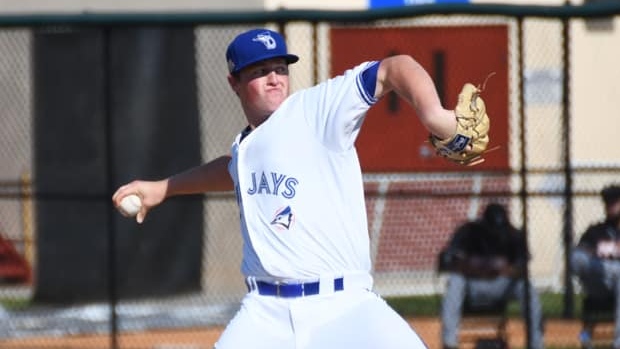
RHP Joey Murray
The next wave of Blue Jays’ pitching prospects will likely start appearing in 2022, but Murray excelled at the alternate training site in Rochester last summer, using his high-spin fastball to get whiffs, just as it’s done in the minors for two seasons since he was drafted in 2018.
Without multiple injuries it’s hard to envision the right-hander, who’s not on the 40-man roster yet, cracking the opening day group, but he might be one of the first names called upon.
Groomed as a starter, he could also pitch in a multi-inning relief role.
He’s the No. 17 prospect in the system.
SECOND-HALF CONTRIBUTOR
RHP Simeon Woods Richardson
The top pitching prospect in the system not named Nate Pearson, SWR’s prospect gains have changed the initial perception of the Marcus Stroman trade, but the Jays liked the 48th overall pick in the 2018 draft more than most, and they’ve been proven right up to this point.
No one should expect a pitcher who’s still just 20 years old for the entire season to play a major role, but his stuff is more advanced than his age and if the Jays are in contention in the second half and SWR is pitching well in the minors — or some sort of alternate site again if the minor-league season can’t get off the ground due to COVID-19 —everything will be on the table.
- Scott Mitchell: State of the Position - Blue Jays’ lineup could be one of baseball’s best
- Scott Mitchell: State of the Position: Room for major improvements in Blue Jays' bullpen
- Scott Mitchell: State of the Position - Questions remain for Toronto Blue Jays’ rotation
Scott Mitchell's State of the Position Series


